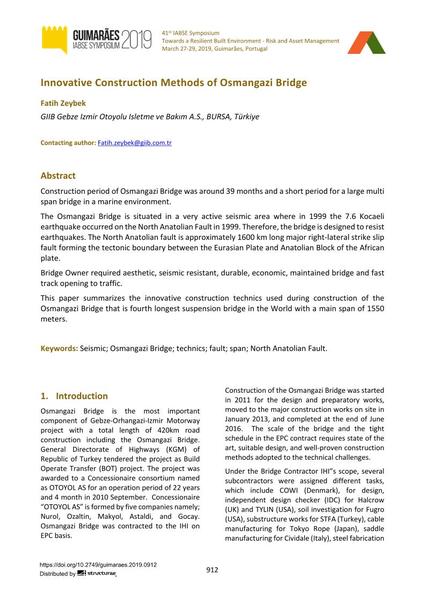Innovative Construction Methods of Osmangazi Bridge

|
|
|||||||||||
Bibliografische Angaben
| Autor(en): |
Fatih Zeybek
(GIIB Gebze Izmir Otoyolu Isletme ve Bakım A.S., BURSA, Türkiye)
|
||||
|---|---|---|---|---|---|
| Medium: | Tagungsbeitrag | ||||
| Sprache(n): | Englisch | ||||
| Tagung: | IABSE Symposium: Towards a Resilient Built Environment Risk and Asset Management, Guimarães, Portugal, 27-29 March 2019 | ||||
| Veröffentlicht in: | IABSE Symposium Guimarães 2019 | ||||
|
|||||
| Seite(n): | 912-918 | ||||
| Anzahl der Seiten (im PDF): | 7 | ||||
| DOI: | 10.2749/guimaraes.2019.0912 | ||||
| Abstrakt: |
Construction period of Osmangazi Bridge was around 39 months and a short period for a large multi span bridge in a marine environment. The Osmangazi Bridge is situated in a very active seismic area where in 1999 the 7.6 Kocaeli earthquake occurred on the North Anatolian Fault in 1999. Therefore, the bridge is designed to resist earthquakes. The North Anatolian fault is approximately 1600 km long major right-lateral strike slip fault forming the tectonic boundary between the Eurasian Plate and Anatolian Block of the African plate. Bridge Owner required aesthetic, seismic resistant, durable, economic, maintained bridge and fast track opening to traffic. This paper summarizes the innovative construction technics used during construction of the Osmangazi Bridge that is fourth longest suspension bridge in the World with a main span of 1550 meters. |
||||
| Stichwörter: |
Spannweite
|
||||
